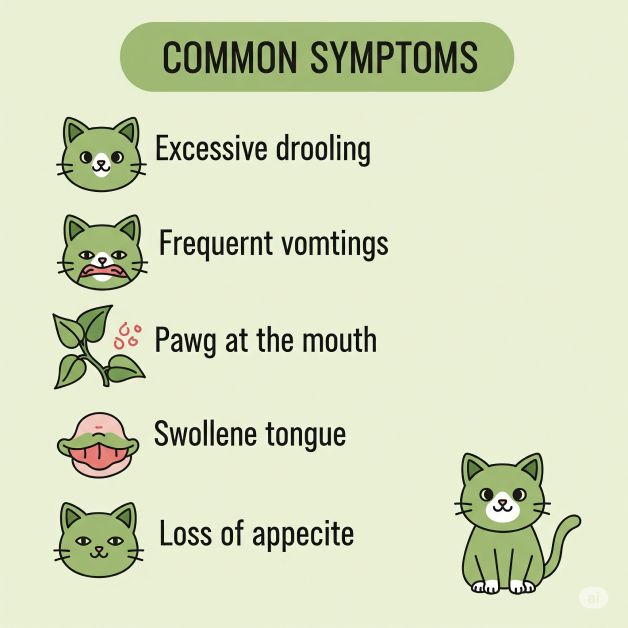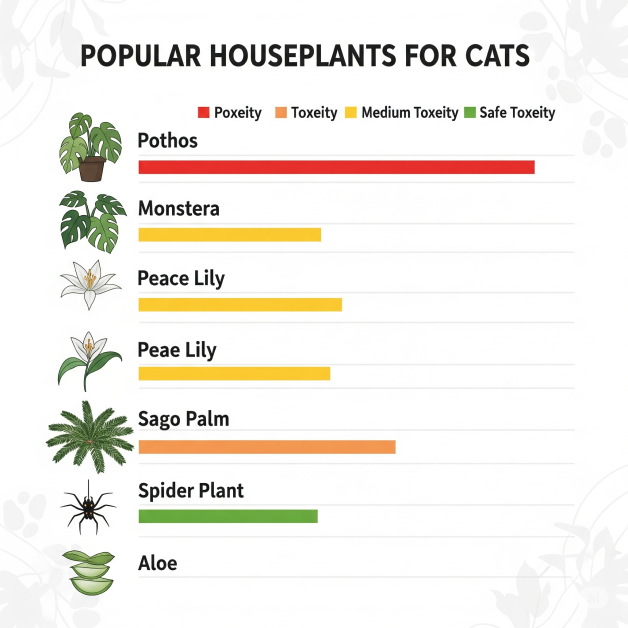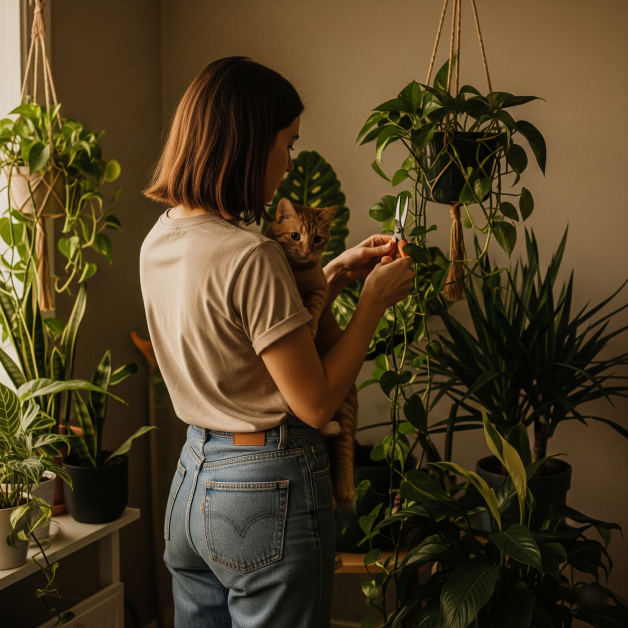Pothos (Epipremnum aureum)—also called Devil’s Ivy—is one of the most popular houseplants for beginners and plant lovers alike. It’s easy to grow, beautiful to look at, and thrives in low light. But if you’re a cat parent, you might’ve paused while scrolling plant care guides and asked: “Is pothos toxic to cats?”
Let’s get into it.
The Short Answer: Yes, Pothos is Toxic to Cats—But There’s More to the Story
Pothos contains insoluble calcium oxalates, a substance that can cause irritation in the mouth, throat, and stomach when chewed or ingested. These sharp, microscopic crystals aren’t deadly in most cases—but they definitely aren’t harmless either.
What Happens If a Cat Eats Pothos?
Symptoms usually include:
- Drooling
- Pawing at the mouth
- Vomiting (usually just once)
- Lack of appetite for a few hours
- Swollen lips or tongue (in sensitive cats)
Severe reactions are rare, but in very young, old, asthmatic, or allergic cats, reactions can escalate—sometimes needing emergency care.

Real Talk: My Experience as a Plant Lover and Cat Parent
I’ve lived with both pothos and cats under the same roof for years. My current cat, a curious tabby named Neko, has nibbled pothos twice—and both times ended with a bit of drooling and one sad little green puddle on the floor.
Nothing life-threatening, but enough to make me relocate my hanging pothos to a high shelf and place cat grass on the floor instead. That solved the issue completely.
What I’ve learned: It’s all about risk management and watching your individual cat’s behavior.

Why Google Might Sound Alarmist
Let’s be honest—when you Google “pothos cat toxic,” you’re bombarded with scary language: “dangerous,” “life-threatening,” “highly toxic.”
But the truth is more nuanced. According to multiple Reddit threads and real-life vet experiences:
- Most cats that nibble pothos get mild symptoms like vomiting or drooling.
- Death or hospitalization is extremely rare and usually involves a unique health condition, a large amount eaten, or a very small cat.
- One Redditor, a vet tech, noted their asthmatic cat had a more severe reaction—so pre-existing conditions matter.
So no, you don’t need to panic—but you do need to be informed and prepared.
How Toxic Are Other Houseplants in Comparison?
Let’s break it down:
| Plant | Toxicity to Cats | Notes |
| Pothos | Mild to moderate | Mouth/throat irritation, vomiting |
| Monstera | Moderate | Same calcium oxalates as pothos |
| Peace Lily | Highly toxic | Can cause serious kidney failure |
| Sago Palm | Extremely toxic | One bite can be fatal |
| Spider Plant | Non-toxic | But can cause upset stomach if over-eaten |
| Snake Plant | Mildly toxic | Causes nausea, vomiting |
| Aloe Vera | Mild to moderate | Vomiting, lethargy, diarrhea |
| True Lilies | Lethal | Even pollen can be fatal |

Pothos Varieties: Are Some Safer?
All pothos types—Golden Pothos, Marble Queen, Neon, Jade, and even Pothos N’Joy—contain calcium oxalates and are equally toxic. So don’t assume a variety with lighter or smaller leaves is safer.
Tips to Keep Cats Safe Around Pothos
Here’s what worked for me—and many fellow cat lovers:
1. Place Pothos Out of Reach
Hang them from the ceiling or put them on tall shelves. Most cats won’t go to extreme lengths unless they’re super plant-obsessed.
2. Use Cat Deterrents
Try citrus sprays (lemon and orange are natural deterrents), motion-activated air puffers, or double-sided tape near pots.
Tip: Lemon is not toxic in tiny trace exposures (like spray scent), but actual lemon fruit/oil ingestion is bad for cats.
3. Offer Safe Alternatives
Place cat grass or wheatgrass nearby. Many cats just want to chew something green. I keep two pots in the living room—and my pothos stays untouched.
4. Supervise and Observe
When introducing new plants, watch how your cat reacts. Some cats ignore plants entirely; others get curious for a week and then stop.

What to Do If Your Cat Eats Pothos
Stay calm and follow these steps:
- Remove any plant bits from their mouth.
- Rinse their mouth gently with water, if they’ll allow it.
- Monitor for symptoms like drooling, vomiting, pawing at the mouth, or labored breathing.
- Call your vet if symptoms worsen or your cat has a pre-existing condition (like asthma).
- Do NOT try to make them vomit or give them human meds.
Read More

Common Problems and How to Handle Them
| Problem | Fix |
| Cat keeps eating pothos | Move the plant, add cat grass, or use citrus spray |
| Cat vomited once after nibbling | Observe—usually resolves in hours |
| Severe symptoms like choking or breathing issues | Emergency vet visit needed |
| Curious kitten in the house | Baby gates, closed doors, and supervision help |
Is Pothos Safe for Other Pets or Humans?
- Dogs: Same as cats—irritation, vomiting, drooling.
- Humans: Toxic if eaten, especially for kids; causes burning or swelling.
- Babies: Keep out of reach just like you would household cleaners.
- Safe in bedrooms? Yes, as long as pets can’t access it.
People Also Ask: FAQ Section
Q: What happens if a cat eats pothos?
A: Mild symptoms like drooling, vomiting, and mouth irritation are common. Severe reactions are rare but possible.
Q: Are pothos pet friendly to cats?
A: No—pothos are considered toxic. Not lethal in most cases, but still unsafe for unsupervised access.
Q: How do I stop my cat from eating my pothos?
A: Use deterrent sprays, elevate the plant, or offer cat grass as a distraction.
Q: Is lemon toxic to cats?
A: In small, indirect doses like a spray, it’s fine. But eating lemon fruit or oil is harmful.
Q: Is pothos toxic to humans?
A: Yes. It causes mouth and throat irritation, especially in kids.
Q: Is pothos safe in the bedroom?
A: Yes—if pets or children can’t reach it.
Q: Is snake plant toxic to cats?
A: Yes, mildly. It can cause vomiting and nausea.
Q: Is it bad to touch pothos?
A: Not really. Just wash hands if you handle the sap or have sensitive skin.
Q: Is pothos a lucky plant?
A: Yes! In Feng Shui, it’s considered to bring prosperity and positive energy.
Q: Does pothos clean the air?
A: It does remove some toxins, but NASA’s air-cleaning study was done in sealed environments—so don’t expect miracles.
Q: How long can pothos survive?
A: With minimal care, pothos can live for 10+ years. They’re incredibly hardy!
Final Thoughts
As a passionate plant parent and cat lover, I believe both can live together peacefully—it just takes awareness, adjustments, and a little bit of trial and error.
If your cat has no interest in pothos, great! But if they’re curious nibblers, be proactive and cautious. No plant is worth risking your furry friend’s health.Happy planting and purring! And remember: when in doubt, move it out of reach.
References
- Are Pothos Toxic to Cats? – The Spruce
- Is Pothos Pet Friendly? – Gardening Know How
- ASPCA Toxic and Non-Toxic Plants List
- Golden Pothos Poisoning in Cats – Wag!
- Satin Pothos Poisoning – Wag!
- Golden Pothos | Pet Poison Helpline®
- Golden Pothos and Cats: Safety Tips – Plantology USA


